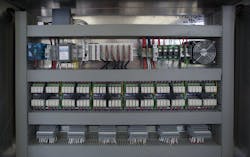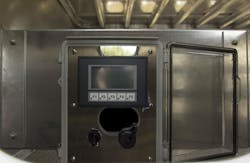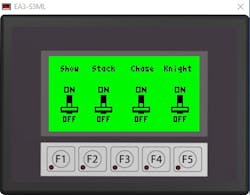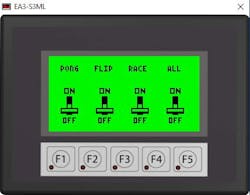A Technology Upgrade for Trucking Chicken Lights
Witnessing a big rig truck rolling down the highway, covered in enough lights to make it look a bit like a Christmas tree, is a fairly common occurrence. These mystifying lights are sometimes called “chicken lights.” Perhaps this is because early 1900s chicken truckers installed them as a practical way to illuminate their cargo and dissuade would-be thievery, or maybe it is because other truckers installed them to make their vehicles more visible to anyone foolhardy enough to try and play “chicken” with the oncoming tractor-trailer.
Regardless, just as many car owners like to customize their rides, today’s truck operators can use lighting as a personal and promotional statement, making their vehicles more visible and appealing and improving safety (Figure 1). Some truck owners view this type of personalization as an attention-grabbing rolling business card for their shop, farm or other enterprise.
Realizing the accelerating demand for big-rig lighting and automation options, the team at Dickerson Custom Trucks now incorporates industrial-grade programmable logic controllers (PLCs) and human-machine interfaces (HMIs) to create eye-catching illumination features and to perform other on-vehicle automation tasks.
Bespoke Big Rigs
Dickerson Custom Trucks in Thorntown, Ind. has been on the forefront of helping truck owners realize their customization visions since Dustin Dickerson founded the company in 2008. Originally, many projects focused on mechanical upgrades of existing equipment. However, in recent years much of the business has shifted into receiving brand new trucks and customizing them, sometimes disassembling them extensively and building them back up, so much so that the shop operates under a “built, not bought” motto.
READ MORE: Emergent Technologies That Improve Productivity and Flexibility
Clients engage the shop due to a proven track record of innovation, according to the company. When it comes to lighting, LED products have made it easier than ever to install even more lights, with each one brighter and using less power than old-school incandescent bulbs. But some of the most enterprising operators began to look for ways to take things to the next level so they could further increase the promotional value of their rigs and enable them to compete in shows. Demand in the marketplace and the availability of newer products and technologies have led the shop to beef up efforts with regards to lighting control and other automation.
While older marker/clearance lights used on trucks and trailers would only be a single Department of Transportation (DOT) certified color such as red or amber, newer devices are available in a 4-wire format which can be operated as a DOT color (dim or bright), and also a selection of alternate colors such as green, blue, purple, pink and white.
A plan was coming together to install these more advanced lights on trucks and trailers, but the team knew they would need some way to control the lights.
Automation That Hits the Road
One customer had a rough vision of how they wanted their brand-new truck and livestock trailer customized, and they commissioned Dickerson to perform the work. This would include stripping the truck to the frame rails, customizing it in many ways and repainting it. Furthermore, having been given a bit of latitude, the Dickerson team suggested that the project include adding linear lighting in a perimeter of almost 100 lights on each side, operated to provide a light show. The customer was thrilled with the idea of using the rig as a large canvas. The Dickerson team had considered projects such as this before, but this would be the first to be executed, so the team got to work developing a way to automate the lights.
READ MORE: Upgrading the Controls for a Machine Builder’s Cotton Press
Although no-one on the team was familiar with traditional industrial automation or programming, some research quickly revealed that a PLC with the proper I/O modules would be a robust and flexible way to control the lights. The CLICK PLC and C-more HMIs, sourced from AutomationDirect, looked to have the proper physical size, electrical ratings and programming features. The AutomationDirect website also offered one-stop shopping for terminal blocks, ZIPLink quick-wiring modules for the I/O, DC-to-DC converters.
Team members were already proficient at wiring and they began installing the lights on the trailer, along with about three miles of wire—an amount that is not uncommon in these lighting systems. They quickly assembled a small control panel to house the PLC and I/O modules and to provide a point to land the wiring (Figure 2).
Creating a Showrunner
Although nobody at the shop had industrial programming experience, a friend of the team helped them quickly learn ladder logic basics. They discovered how straightforward the PLC and HMI development environments were to learn and use and quickly created their first display and associated user graphics (Figure 3).
The amber elements of each light are either off, dim or at full brightness and are operated as an entire group. PLC discrete outputs are used to individually control the green element of each light. Different programs can make the lights blink, chase each other or perform other patterns.
Early iterations of the light show were fairly basic, but the team was soon creating more advanced patterns and the drivers were calling for more. As the truck went to each new event, the team tasked themselves with creating a new and unique lighting show, which now includes six unique operating styles. There is one main program that can initiate all individual styles. All code is written in ladder logic and drum sequencers provide an efficient way of coding the light patterns.
READ MORE: The PLC Breaks Out!
Happy Trails
The skilled team at Dickerson has many years of experience, but integrating industrial automation into their work was a new endeavor. They were happy to find a family of solutions that was straightforward to specify, easy to learn and fast to deploy. Whenever they had a few questions along the way, they were able to resolve them using the clear documentation, online video library and phone support.
Automating big rig trailer lighting is just the first step for the shop. Based on the positive experience, they plan to expand PLC/HMI technology into other aspects of their work and they now have complete flexibility to automate whatever they choose.
With the ability to easily add customized industrial-grade automation into their projects, the shop is differentiating itself from other players in the field, and the sky is the limit for adding valuable capabilities into projects for their customers.
Dustin Dickerson is the founder and owner of Dickerson Custom Trucks in Thorntown, Ind. He has been in the truck building business for about 15 years, and welcomes the opportunity to create innovative designs with his clients.





